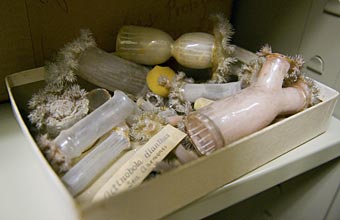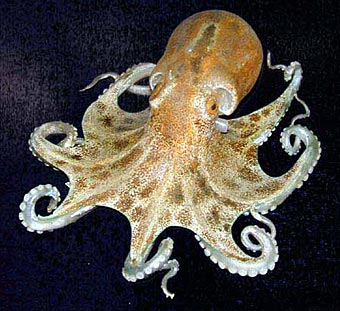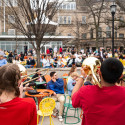‘Glass menagerie:’ Museum unearths exotic stash of glass sea creatures
An ordinary mid-summer stroll through Noland Hall in 2005 led Paula Holahan to an extraordinary discovery.

Fragile glass sculptures of marine invertebrate animals await repair in a storage cabinet at the UW–Madison Zoological Museum. Crumbling from age, the intricate glass models were found by Zoological Museum curator Paula Holahan in boxes hidden in Noland Hall. Sleuthing work by Holahan led to information that suggests the models were made by Leopold and Rudolph Blaschka, a 19th-century father-and-son team of German glassmakers, and purchased in 1890 by Edward A. Birge, a former UW–Madison president, dean and zoology professor, and one of the first curators of the Zoological Museum.
Photo: Jeff Miller


Restored Blaschka marine models at Cornell University.
Courtesy: William Warmus and Cornell University
A series of keyholes under the exhibit cases along a first-floor corridor caught her eye. Curious, she dug up the keys and unearthed the contents.
She discovered box after box filled with a sea of intricate glass sculptures of marine invertebrate animals — jellyfish trailing masses of tentacles, spiny spherical radiolarians, sea anemones bristling with tiny tentacles. The delicate figurines were incredibly detailed but beginning to fall apart from age.
"It’s not uncommon to find things packed away in any museum that is over 100 years old," says Holahan, one of the curators of the UW–Madison Zoological Museum, currently located in Noland Hall. "The Zoological Museum has been housed in three different buildings since 1887."
But this particular find – not just your average fossil or box of bones – launched Holahan on a quest to identify the models: who made these creatures and how did they get here?
Art or science?
Wooden bases on some of the figures still retain small hand-lettered labels. Recognizing the label style, Holahan traced the models to a popular scientific supply-house of the late 1800s, Ward’s Natural Science Establishment, which still operates today in Rochester, New York. On smaller tags on the underside of several bases, she also noticed the word "Blaschka."
These clues and some help from the Internet led Holahan to Leopold and Rudolph Blaschka, a 19th-century father and son team of German glassmakers.
Descended from a long line of glass-workers, Leopold and Rudolph supported themselves by making glass eyes and jewelry before turning their skills to the natural world in the mid-1800s.
As popular interest in the history and sciences of the natural world burgeoned during the latter half of the 19th century, the sea became particularly alluring. The spread of home aquariums and the advent of deep-sea diving revealed a new frontier, filled with wondrous and unusual creatures.
The Blaschkas were commissioned by museums to create glass models that would capture the exotic species’ fanciful shapes and vivid colors. Other models were sold for exhibit or instruction at universities or even as elegant knickknacks for private homes.
"These were highly in demand. The living animals were often so minuscule and delicate, [models were] an ideal way to demonstrate what they looked like," says Holahan.
Working from illustrations or live or preserved specimens, the Blaschka craftsmen meticulously reproduced the spikes, polyps, and suckers of their aquatic subjects. They preserved an impressive degree of scientific accuracy, even modeling the tiniest creatures at 600- to 1,000-times actual size to show fine detail, Holahan says.
The Blaschkas pioneered many of their techniques and developed original formulas for their glasses, glues, and colored enamels. They experimented with methods, sometimes using internal wires for support and other times painstakingly gluing on individual spines and tentacles.
As demand for the creations increased, the father-son team developed a catalog of individually hand-made models of a range of sea invertebrates, from sponges and corals to squid and sea anemones. Over time, they created models of more than 700 different species for museums, laboratories, and classrooms across Europe and the United States.
Only a few collections are known to remain today.
A piece of Birge’s legacy
Thanks to Edward A. Birge — former UW–Madison president, dean, and zoology professor and one of the first curators of the UW Zoological Museum — one of those collections belongs to UW–Madison.
In the wake of a devastating fire in Science Hall on Dec. 1, 1884, which destroyed many of the university’s scientific collections, Birge was faced with the challenge of replacing research and teaching equipment and supplies.
In February 1890, he ordered a selection of Blaschka-made sea life from Ward’s Natural Science catalog, recorded in his purchasing ledger simply as "glass models," for a total sum of $185 (roughly $4,000 in today’s dollars). Though there is no way to confirm how many or which models Birge ordered, the prices listed in Ward’s 1888 catalog range from 30 cents for a single simple anemone to $12 for a display featuring multiple developmental stages of a sponge.
The pieces Holahan recovered, carefully boxed and wrapped in newspaper from 1962, include a mix of jellyfish, anemones, radiolarians, and sea cucumbers, along with an assortment of parts – about 50 models all told.
Despite their delicacy, the models were used in invertebrate zoology and marine biology classes at UW–Madison, Holahan says. "Think – these were put out in labs for students to look at."
Brittle stars
Now showing their age, the models must be cleaned and repaired before they can be publicly displayed.
"They should not be disturbed or moved until they can be properly conserved," Holahan says.
Restoring the collection will not be a simple task. The fragility of the figurines and deterioration of the handcrafted glass and glues will make the undertaking much like restoring artwork.
The gradual deterioration of Blaschka models reflects the instability of the materials they contain, says Stephen Koob, a conservator at the Corning Museum of Glass in Corning, New York, who has repaired Blaschka models owned by Cornell University.
For example, Leopold Blaschka relied heavily on animal-based adhesives to connect parts of the models and adhere pigments. Such adhesives are "not very effective in the long term," he says. "These adhesives are nearing the end of their lifetimes."
Moreover, the Blaschkas’ proprietary glass and adhesive recipes died with Rudolf in 1939, leaving proper repair and conservation procedures unclear. The wrong approach, no matter how well intentioned, could be catastrophic, Holahan says.
"It’s like cleaning old paintings – sometimes we can do more harm than good," she says. "This is a real challenge for glass conservators."
"Any movement – caused by handling or moving – can cause pieces to separate and fall apart," agrees Koob. "Vibration takes its toll."
Despite the challenges, successful restoration is possible. Collections of Blaschka glass animals or flowers are exhibited or stored at the British Museum in London, Trinity College in Dublin, Cornell University in Ithaca, New York, and Harvard University in Cambridge, Massachusetts.
The Zoological Museum plans to restore its collection, Holahan says, though the demanding process will be costly and "currently there are not funds available for this undertaking."
The models are currently too brittle to exhibit and must remain in storage until conservation measures are funded and completed. Holahan hopes to find someone interested in sponsoring the repairs before the effects of age become irreversible.
"Time is the critical element," she says. "We’ll wait and see."



